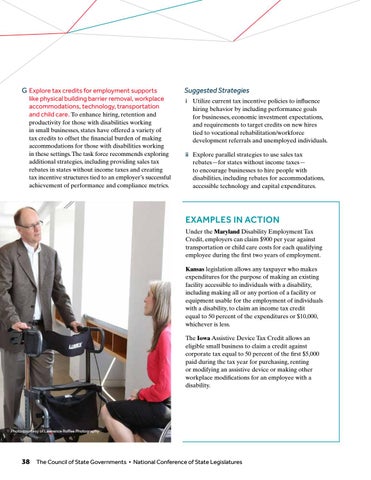G Explore tax credits for employment supports like physical building barrier removal, workplace accommodations, technology, transportation and child care. To enhance hiring, retention and
productivity for those with disabilities working in small businesses, states have offered a variety of tax credits to offset the financial burden of making accommodations for those with disabilities working in these settings. The task force recommends exploring additional strategies, including providing sales tax rebates in states without income taxes and creating tax incentive structures tied to an employer’s successful achievement of performance and compliance metrics.
Suggested Strategies i Utilize current tax incentive policies to influence hiring behavior by including performance goals for businesses, economic investment expectations, and requirements to target credits on new hires tied to vocational rehabilitation/workforce development referrals and unemployed individuals. ii
Explore parallel strategies to use sales tax rebates—for states without income taxes— to encourage businesses to hire people with disabilities, including rebates for accommodations, accessible technology and capital expenditures.
EXAMPLES IN ACTION Under the Maryland Disability Employment Tax Credit, employers can claim $900 per year against transportation or child care costs for each qualifying employee during the first two years of employment. Kansas legislation allows any taxpayer who makes expenditures for the purpose of making an existing facility accessible to individuals with a disability, including making all or any portion of a facility or equipment usable for the employment of individuals with a disability, to claim an income tax credit equal to 50 percent of the expenditures or $10,000, whichever is less. The Iowa Assistive Device Tax Credit allows an eligible small business to claim a credit against corporate tax equal to 50 percent of the first $5,000 paid during the tax year for purchasing, renting or modifying an assistive device or making other workplace modifications for an employee with a disability.
Photo courtesy of Lawrence Roffee Photography
38 The Council of State Governments • National Conference of State Legislatures
